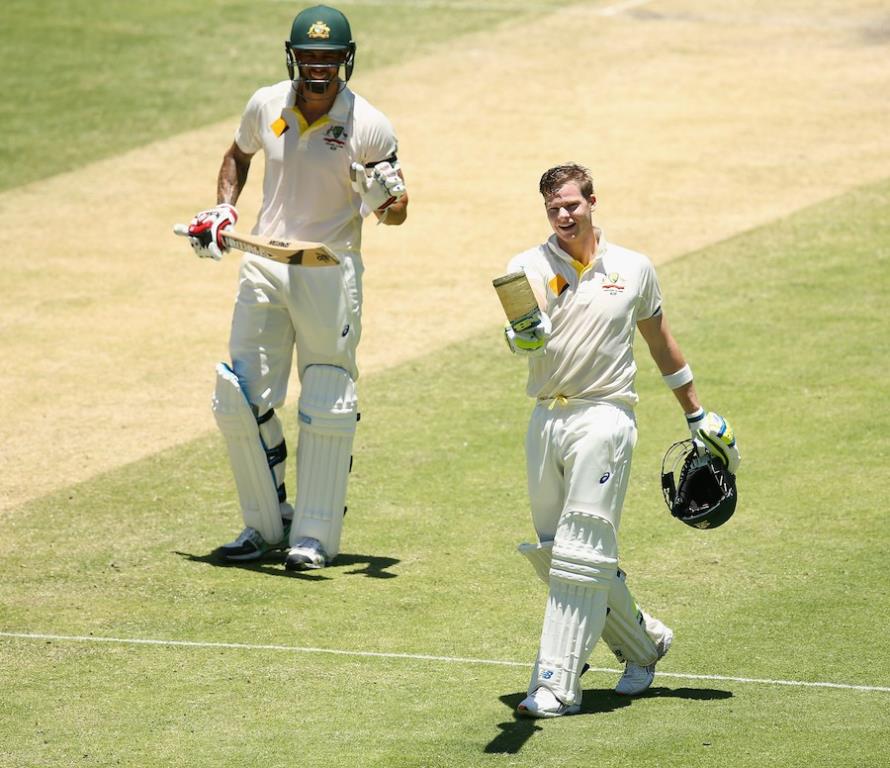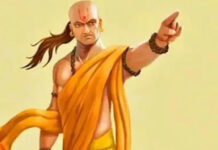December 19, 2014
Brief Scorecard: India 408 and 1 for 71 trail Australia 505 (Smith 133, Johnson 88) by 26 runs

Steven Smith acknowledges the cheers on reaching his hundred, Australia v India, 2nd Test, Brisbane, 3rd day, December 19, 2014
December 19, 2014
Brief Scorecard: India 408 and 1 for 71 trail Australia 505 (Smith 133, Johnson 88) by 26 runs

Steven Smith acknowledges the cheers on reaching his hundred, Australia v India, 2nd Test, Brisbane, 3rd day, December 19, 2014
BRISBANE, AUSTRALIA – There is something singular about watching Test cricket in Australia. The sky is a shade of blue usually only sighted in animated films. The freshly mown grass on the outfields could put billiards-table baize in the shade. The coruscating afternoon sun shines down as though its only purpose is to brighten the whites of 13 hard men locked in battle. But, more than all this, it’s the pitches, the most important 22 yards in cricket that breathe life into the game.
And on the third day of the second Test, Australia asserted themselves at home, putting 505 on the board and then winkling out one Indian second-innings wicket, showing just why aspiring conquerors would do well to try their luck elsewhere. An Australian stirred is a force to reckon with, and India learned this the hard way on Friday (December 19).
India’s best phase in the day came first thing in the morning when the fast bowlers overcame the heat to run in strongly and ask questions of Steve Smith and Mitchell Marsh. A period of sustained inquiry where almost every ball was sent down with a specific purpose in mind, in an attempt to execute a plan, kept Smith quiet.
Ishant Sharma was the epitome of control, and the spring in his step showed just how much he was enjoying himself. Marsh, struggling with a hamstring injury, was having decidedly less fun and he was put out of his misery in the fifth over of the morning. Shouldering arms to Ishant, Marsh could only look in horror as the ball jagged back in to trigger the offstump.
Brad Haddin joined his captain out in the middle and found Umesh Yadav in the middle of a probing spell. Keeping the ball full enough to look for swing yet not so full that it may be driven without risk, Umesh repeatedly beat the bat, digging deep into reserves of stamina – much as his father would on one of his trips down a coal mine in Vidarbha – to keep the pressure up. But it was Aaron who reaped the reward, bombing Haddin with a short ball angled into the body from around the stumps. Fending awkwardly, Haddin made soft contact, the ball floating to the fielder under helmet as an autumn leaf might on a still day.
The Gabba crowd, small but vocal, throats suitably lubricated by tall glasses of crisp beer, went dead quiet as a hush descended, briefly turning the most adversarial of all cricket grounds into a decidedly less forbidding place. The crowd was stunned at the temerity of these visitors, who paid no heed to history: did they not know that Australia have not lost at this venue since 1988?
India wanted an early wicket on the third day to get their noses ahead, and they had two, with Australia six down, the tail exposed and still trailing by 161. Here was the chance of a lifetime as this young team found itself in a position that few who had come to these lands before them had ever achieved.
And, instead of embracing the method that had got them this far, India had a brain fade. Rohit Sharma welcomed Mitchell Johnson to the crease with a taunt, asking the quick bowler just how many wickets he had taken in the game. A tentative starter usually, Johnson steeled himself, and, as though some hidden switch had been thrown, blazed a trail that gave the crowd enough cause to regain its lost voice.
Trying to keep up the short-ball barrage even though the quicks were flagging, India were treated to some sumptuous pulls, Johnson attacking relentlessly. The ball boomed off Johnson’s bat in front of square and behind, fielders watching helplessly as a bright stand burgeoned. Smith, who had barely broken sweat in reaching his second century of the series, his first as Test captain of Australia, merely protected the partnership, feeding Johnson the strike.
When the bowlers finally realized the futility of banging the ball in, Johnson cleared his front leg and drove brutally back down the ground. Even the late introduction of R Ashwin did not break the flow, Johnson launching the ball back over the bowler’s head with the swing of a golfer teeing off on a long par five.
The 50 of the partnership came before the Indians realized what had hit them, off only 37 balls, and when this stretched to three figures, off 82 balls, the bowlers and fielders were in a world of pain. Fortunately for the fielding side, there were no further landmarks as Johnson (88, 93b, 13×4, 1×6) flashed one time too many and nicked to the ‘keeper. Ishant, who picked up the wicket, could not even bring himself to celebrate. Johnson’s withering assault had reduced India from a position of strength to one of vulnerability, positivity being stripped off slowly but surely, much like the snow on a peak being burned off by the first rays of spring.
If India were relieved by Johnson’s departure, quickly followed by Smith (133) dragging a ball back onto his stumps, these comforting thoughts were premature. From 398 for 8, the tail wagged – Mitchell Starc (52), Nathan Lyon (23) and Josh Hazlewood all chipping in as Australia put together 505.
Trailing by 97 when they could have just as easily been sitting on a lead, India batted out a tricky 23 overs to reach 71 for 1, losing only M Vijay, with whom the law of averages finally caught up. There was plenty of work left for the Indians in the two remaining days, if they hoped to continue keeping Australia at bay.
Courtesy: Wisden India





































































































